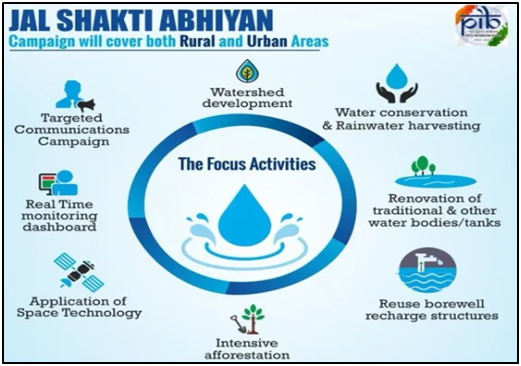Why in news?
Union Jal Shakti Minister has said that the government was conceiving a new project to ensure that rural households, which were provided taps under the ambitious Jal Jeevan Mission but had not yet been able to avail water, would soon be provided potable water.
What’s in today’s article?
- Jal Jeevan Mission (JJM)
- Performance of JJM so far
- Challenges to JJM
Jal Jeevan Mission
- About
- Jal Jeevan Mission is envisioned to provide safe and adequate drinking water through individual household tap connections by 2024 to all households in rural India.
- It was launched on August 15, 2019.
- The focus of this mission is on assured and regular potable water service delivery at household level, i.e., water supply in adequate quantity (55 litres per person per day).
- JJM is a decentralized, demand-driven, and community-managed programme that aims to instil a ‘sense of ownership’ among the local community.
- Nodal Ministry
- Department of Drinking Water & Sanitation under the Ministry of Jal Shakti is the nodal institution responsible for implementation of this mission.
- Key detail
- The programme also implements source sustainability measures as mandatory elements, such as:
- recharge and reuse through grey water management, water conservation, rain water harvesting.
- The mission is based on a community approach to water and will include extensive Information, Education and communication as a key component of the mission.
- JJM looks to create a janandolan for water, thereby making it everyone’s priority.
- Focus activities
- Measurement process
- To measure water connections provided to households, State or Union Territory water supply departments collect data from districts and report it to the Jal Shakti Ministry.
- This data shows that 19 crore rural households have been given tap connections.
- To verify this, villages, through their gram panchayats, self-certify if households actually receive water. This double-checks the state-provided figures.
Performance of the scheme
- Status of tap water supply in rural homes
- As of June 26, 2024, the scheme had encompassed 77% of its target household.
- Households with tap water connections as on June 26, 2024 – 14,91,32,648 (77.22%).
- However, it should be noted that there is a difference between a household getting a tap connection and the daily quota of 55 litres per person day of water being provided.
- Har Ghar Jal Status
- Achieving the Har Ghar Jal Status means:
- all households have been connected,
- the water supply department has certified water supply to homes, schools, and anganwadis, and
- a gram sabha resolution has confirmed the department's claim.
- Certified States/ UTs (certified by Ministry): Goa, A & N Islands, Puducherry, D&NH and D&D, Arunachal Pradesh, Haryana, Punjab.
- Reported States/ UTs: Telangana, Mizoram, Himachal Pradesh, Gujarat.
- The Jal Shakti Ministry has a portal showing target achievements by States.
- According to this, out of 2,24,678 villages claiming 100% tap connectivity, only 1,21,974 have self-certified.
- It is, however, unclear how many of the 19 crore households truly have functional tap water connections.
Challenges to JJM
- Infrastructure Development
- Establishing the necessary infrastructure in remote and rural areas is a significant challenge.
- This includes the construction of pipelines, water treatment plants, and storage facilities.
- Water Quality
- Ensuring the quality of water supplied through the taps is crucial.
- Contaminants like fluoride, arsenic, and nitrates in groundwater sources pose health risks and require robust treatment solutions.
- Sustainability
- Maintaining the water supply systems and ensuring they remain functional over time is essential.
- This includes regular maintenance, timely repairs, and efficient management of water resources.
- Funding and Resources
- Adequate funding and resource allocation are vital for the success of the mission.
- Ensuring that states and local bodies have the financial and human resources to implement and maintain the systems is a continuous challenge.
- Community Participation
- Engaging local communities and ensuring their active participation in the planning, implementation, and maintenance of water supply systems is critical.
- Building awareness and training local stakeholders is necessary for the mission's success.
- Geographical Challenges
- Diverse geographical conditions across India, such as hilly terrains, deserts, and densely populated areas, present unique challenges in laying pipelines and ensuring a consistent water supply.
- Data Accuracy and Verification
- Accurately reporting and verifying the number of functional household tap connections is challenging.
- The self-certification process by gram panchayats is essential but can be prone to discrepancies.
- Coordination Among Agencies
- Effective coordination between various government agencies at the central, state, and local levels is crucial.
- Overcoming bureaucratic hurdles and ensuring seamless collaboration can be difficult.










